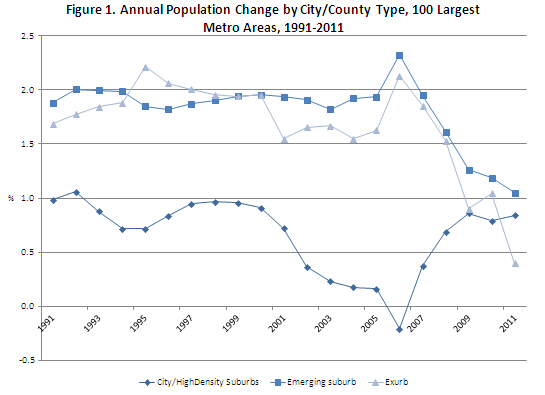
Last week, the New York Times and USA Today reported that Census numbers had confirmed the death of the outer ring suburbs, or exurbs. The latest numbers, capturing the year (actually 15 months, April 2010 to July 2011) since the last Census, showed a major shift away from the settlement patterns from 2000 to 2010.
That’s not exactly how it happened. The shift didn’t suddenly happen in 2010. The 2000-2010 numbers encompass a decade whose first two-thirds were the heyday of an economic boom that buoyed greenfield development. The real break was in 2007, when the housing bubble burst and the artificially inflated value of the outer suburbs crashed. After all, those houses weren’t near any employment centers or amenities, and the price of gas was creeping terrifyingly upward, forcing exurbanites to pay top dollar to get to work, if they still had a job to go to.
The whole last third of the decade showed a populace flinching back from what was quickly proving itself to be a toxic development pattern. Last year’s numbers are a continuation of what’s been happening since 2007, not a sudden year-over-year change.
What has emerged from the analysis of this year's Census data, though, is a complicated picture of stalled-out growth in distant suburbs that had developed at a breakneck pace during the housing boom, fueled by overzealous marketing and easy mortgages. Cities have re-absorbed some of those people, but the biggest metros chalked up only modest population increases. And the cities that grew the most were relatively sprawling southern and western cities, like Dallas and Miami, that defy the urbanism of old eastern cities like Boston or Philadelphia.
Fleeing the Exurbs
The Census Bureau itself didn’t actually say anything about exurbs. It focused on the dramatic shift in development patterns over the last decade, highlighting in its press release that the fastest growing areas between 2000 and 2010 were not the same ones that grew the fastest from 2010 to 2011.
So where are the Times and USA Today getting this “exurbs are dying” thing? They’re getting it from William Frey, a demographer at the Brookings Institution. He’s been talking about the flagging energy for exurban growth for years, most recently in a report released two weeks ago on the population shift away from outer suburbs and toward metros with diversified, knowledge-based economies.

Frey's own analysis looked past which metro areas won or lost in the last year to the finer-grained county data. The Census noted, “The three fastest-growing counties from 2000 to 2010 were Kendall, Ill.; Pinal, Ariz.; and Flagler, Fla. Between 2010 and 2011, they ranked 236th, 171st and 207th, respectively.” And Frey’s analysis showed that it wasn’t just those flagship exurban communities that were losing favor.
Frey found that population in the country’s outer suburbs grew at just 0.4 percent in the year that ended last July, down from 1 percent in the previous year and a 2006 peak of more than 2 percent.
Rural counties last year grew at one-quarter of their rate of growth between 2000 and 2010, but some grew by leaps and bounds. North Dakota, one of the most rural states in the nation, experienced some of the greatest growth in the last year due to major oil and gas development.
Forty-seven micro areas now have populations of 100,000 or more, with the most populous, Seaford, Delaware, now housing 200,000 residents. Considering that a micropolitan area is defined by having no more than 50,000 people in its largest city, a micro area that big is inherently sprawling.
What About the Major Metros?
After the newspapers had already run headlines using his findings, Frey released his own analysis on the Brookings blog. He noted that it’s not as simple as saying that big cities grew while exurbs flailed. Many cities, like Las Vegas and Orlando, experienced a major crash in population and housing values as well. And some of last year's fastest growers, by percent population gain, were hardly the country's most booming urban centers: Kennewick-Pasco-Richland, Washington and Hinesville-Fort Stewart, Georgia, for example.
A diversified, knowledge-based economy is one key element of the cities that have fared well, Frey said. Houston, New York and D.C. gained more than 100,000 people each.
Yonah Freemark of The Transport Politic drew out some of the finer points in his story yesterday, focusing on growth in the core counties of some of the most important metro areas. “Whereas just 3.8 percent of the Washington region’s population growth between 2000 and 2010 occurred in the District of Columbia itself, 13.4 percent of the same region’s growth between 2010 and 2010 occurred in the central city,” wrote Freemark. “Most extreme, perhaps, was the situation in Cook County (the central county for the Chicago region), which took in 51.3 percent of the region’s population growth between 2010 and 2011, while the county had declined significantly in population between 2000 and 2010.”
Freemark added that the core of the core – the downtowns – were already experiencing a renaissance in the 2000s, and this new data shows that that growth is spreading to other neighborhoods within the most urban county. Of course, in some cases, county boundaries match up precisely with city limits (New York City or New Orleans, for example), and in others (Miami, Atlanta, Cleveland) the city population is a small percentage of the population of the entire county. And he was careful to note that growth in the core county only outpaced growth in surrounding areas about half the time.
Delayed Reaction
Another factor complicating this demographic data is the fact that people move less during periods of economic uncertainty. And if they move, it might not be to their ideal location. We can’t assume that the migration patterns we’re seeing in the latest Census data reflect people’s preferences.
“The reason you see so much clustering of people in these close-in suburbs and urban areas is that a lot of these are young people – you might call them windfall stayers,” Frey told Streetsblog in an interview. “They would have moved out if they could, but for the meantime they’re staying where they are, with parents or friends. In Washington, D.C., for example, you see somewhat higher growth than normal in Arlington, Alexandria and the close-in suburbs than earlier in the decade, when people were moving out to the exurbs more.”
He said that young people who seek out outer suburbs for the lower housing prices, especially those starting families, are “biding their time while they’re waiting to make the move.” So when the economy bounces back a little more, there might be a lot of latent demand for those exurbs.
But, Frey said, when these people do find the means to make their move, they might think twice about going back to subdivisions that are still struggling with massive waves of foreclosures. “The exurbs may be a little toxic for a while,” Frey said, “both for people who want to move there, people who want to provide loans for people who want to move there, and people who want to develop there.”





